This short webinar series, developed by the Amphibian Ark, provides an interactive, online forum where managers of ex situ amphibian programs can discuss some of the main challenges program managers and keepers might have as they strive to reach their conservation goals. The content of the webinars follows the key steps in establishing and maintaining a successful ex situ amphibian conservation program. Each session runs for 60 minutes.
The first step is to be successful in obtaining founder animals and maintaining them in optimal conditions. There are different sampling techniques that help us to find founder animals, in the case where a source of captive individuals from other institutions is not available. An overview of the logistics for doing remote fieldwork where many priority species occur will be presented during one of the webinars.
Water quality, lighting and nutrition are some of the important husbandry aspects that program managers need to be very aware of if the program is to be successful. Biosecurity is also very important, especially for animals which will eventually be reintroduced into the wild. These topics will be covered during the husbandry webinars.
One of the exit strategies of any amphibian ex situ conservation program is reintroduction of the offspring to the wild. One of the post-release monitoring techniques is radio-telemetry, and a presentation during the webinar series will discuss this activity.
The following presentations were delivered over the course of the series. Click on each video image to view the presentation. The complete set of videos is also available as a playlist on YouTube.
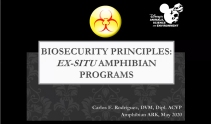
Biosecurity Principles: Ex Situ Amphibian Programs Carlos E. Rodriguez The role of biosecurity in any animal operation, particularly in amphibian programs, is of crucial importance. In this presentation we discuss the guiding principles and practical approaches to setting up a sound biosecurity plan taking into account the role and purpose of the species and the location of the facilities. We also discuss salient and important principles of disinfection techniques applicable to animal programs. Finally, we discuss the role of quarantine as a disease barrier to established programs and use of the risk assessment matrix to identify threats and direct how to apply these techniques. |
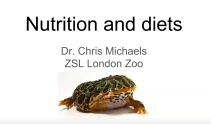
Christopher Michaels The diet used to maintain captive amphibians is a key component of husbandry and can make or break a program. In this talk, Chris looks at some of the fundamental principles and considerations to make when designing diets for captive amphibians as well as some guidelines on how to tailor diets to the species in question. |

Water quality in ex situ amphibian husbandry Christopher Michaels Amphibians are unique amongst terrestrial vertebrates in their strong ties to environmental water, and many species utilize aquatic habitats for at least part of their lives. This talk explores the fundamental components of water quality and chemistry, their relevance to maintaining amphibians in captivity, and how they can be managed in artificial systems. As amphibians have adapted to a wide variety of freshwater and hyposaline habitats, this information is designed to serve as a foundation of knowledge that can be applied to any husbandry situation, rather than a one-size-fits-all approach. |
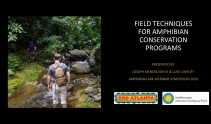
Field techniques for amphibian conservation programs Joseph Mendelson and Luke Linhoff Amphibian conservation often requires working in the field. Monitoring wild amphibian populations and being able to safely collect, transport and release animals are critical techniques for success. We review basics of field sampling techniques for biodiversity inventories and population monitoring protocols, with recommendations of technical references that have more detailed information. Biodiversity inventories and field monitoring (for example to track trends in a focal population or to assess status of reintroduction efforts) are very different tasks and involve different techniques that we discuss. |
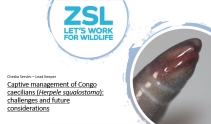
Francesca Servini Caecilians are a vastly understudied species, due to difficulties observing them in the wild and in captivity. The Zoological Society of London currently holds two species of caecilian: Congo Caecilians (Herpele squalostoma) and Cayenne Caecilians (Typhlonectes compressicauda). The Cayenne Caecilian is an aquatic species, and therefore is easier to study and has allowed us to observe breeding events in the past, however the Congo Caecilians are fossorial, which presents numerous husbandry challenges in captivity. This presentation discusses these challenges, what we have done to overcome them, and what our future aims are with our captive group in regards to better management and breeding. |
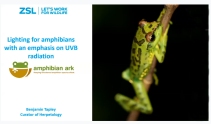
Lighting for amphibians, with an emphasis on UVB radiation Ben Tapley Light is a free and often plentiful resource and optimal levels of light are likely to be those experienced by animals in nature. This session will cover the basics on the provision of lighting for amphibians in captivity with a focus on adopting species-specific and evidence-based husbandry protocols. There will be a particular focus on the provision of UVB radiation. |

Catering to amphibian larval husbandry Christopher Michaels Amphibians often have larval phases in their life histories. Amphibian larvae are often so different in structure and ecology from their parents that they constitute different ecological species. As such, husbandry practitioners working with a species with a larval phase must consider the husbandry of the larva as closely as the adult. This talk looks at some of the basic principles and practical tips for rearing amphibian larvae in captivity. |

Experimental approaches to improve ex situ conservation of anurans Richard Preziosi This talk presents a series of studies examining how we can develop an evidence base for improving ex situ husbandry. It focuses on aspects of enclosure design and on the delivery and effect of carotenoid supplementation in the diet. |







